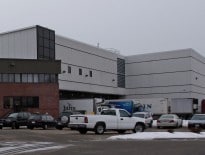Communities around Greater Boston, in partnership with the MBTA, will seek to create faster and more reliable commutes for more than 30,000 bus riders through a sequence of three pilot projects testing bus rapid transit (BRT) features over the course of 2018.
The pilots will include a combination of dedicated bus-only lanes that take bus riders out of car congestion, technology to time traffic signals so that buses get more green lights, and platforms that allow riders, including people in wheelchairs or with baby strollers, to “level-board” the bus quickly as they would a subway.
The projects are an effort of BostonBRT, an initiative spearheaded by the Barr Foundation. BostonBRT issued a competitive request for proposals in January. The Barr Foundation this week announced three $100,000 grants to advance projects in Arlington, Cambridge, Watertown and Everett. The RFP invited municipalities to partner with the MBTA to demonstrate the potential of BRT in high-ridership, high-traffic areas, with the goal of improving the transit experience for the most people. During peak commute times, there are twice as many people in buses than cars in the combined corridors – with the potential for that number to grow with a more efficient and convenient bus system.
“These pilot projects will show BRT’s potential to transform how people in Greater Boston get to where they need to go, and how BRT can fit within the region’s transportation system,” Mary Skelton Roberts, co-director for climate at the Barr Foundation, said in a statement. “For BRT to be successful, local and state governments, communities and transit experts need to work together. These winning proposals demonstrated their readiness to do so. And we hope their commitment to collaboration during this pilot testing periods is just the beginning. Massachusetts residents deserve flexible, environmentally-sustainable transportation options they can count on like BRT.”
“With hundreds of thousands of our daily riders relying on buses to get them to their destinations in a timely manner, it’s terrific to have partners like the Barr Foundation and BostonBRT working with us to implement improvements,” MBTA General Manager Luis Manuel Ramirez said in a statement. “We owe it to all of our customers, particularly those for whom buses are their primary mode of commuting, to do everything we can to provide them with consistently reliable service.”
Elements Of BRT
- Arlington will conduct a one-month pilot of several BRT elements on the 3-mile #77 bus route along Massachusetts Avenue, the town’s main thoroughfare, which has the highest ridership in Arlington and one of the top 15 highest-ridership routes in the overall MBTA bus system. The pilot, which will operate Monday through Friday, 6 a.m. to 9 a.m., includes transit signal prioritization, bus queue jumping at traffic signals and a dedicated bus priority lane.
- Cambridge and Watertown will pilot numerous BRT elements for bus routes on Mount Auburn Street west of Fresh Pond Parkway. Elements to be tested include all-day, dedicated bus lanes for significant segments of Mount Auburn Street between Belmont Street and Fresh Pond Parkway, inbound queue jump lanes on Mount Auburn Street and Belmont Street, and transit signal prioritization as feasible, which allow buses to travel without impediment from other vehicles.
- Everett’s pilot includes “platform level” boarding facilities, which allow of ease of boarding for riders in wheelchairs, strollers or carts, at two bus stops in Everett Square, and transit signal prioritization at three locations along Broadway to give southbound buses priority during peak hours.
As part of the grant funding, BostonBRT will assist communities with coordination between state and municipal agencies, pilot design and implementation, communications, and community engagement. All of these pilot programs are being done in collaboration with the MBTA.




 |
| 
